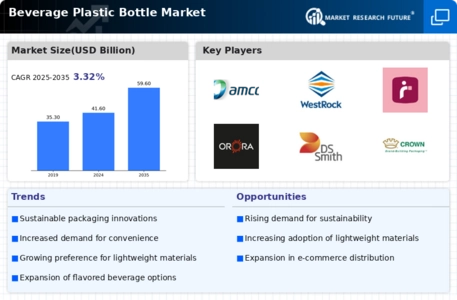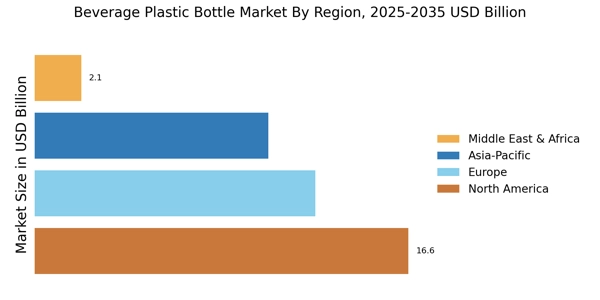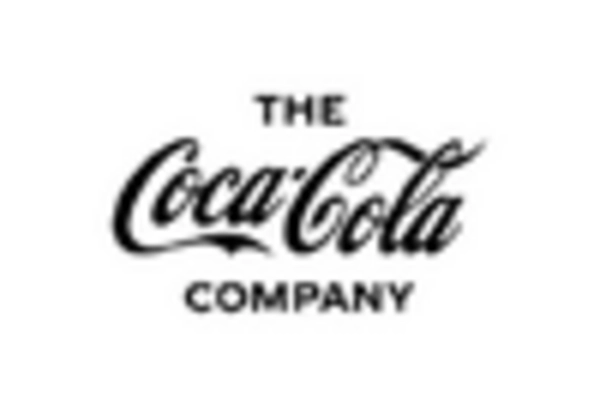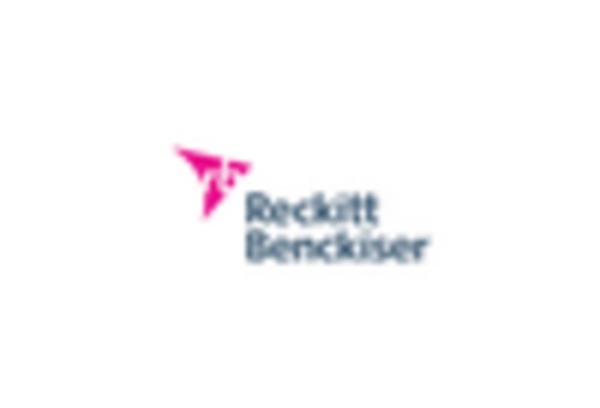Regulatory Compliance
Regulatory compliance is a critical driver in the Beverage Plastic Bottle Market, as governments worldwide implement stricter regulations on plastic usage and waste management. In 2025, it is anticipated that new policies will mandate increased recycling rates and the use of recycled materials in packaging. This regulatory landscape compels manufacturers to adapt their practices, often leading to increased investments in sustainable technologies and materials. Companies that proactively comply with these regulations not only mitigate risks but also enhance their brand reputation among environmentally conscious consumers. Thus, regulatory compliance is expected to significantly influence the Beverage Plastic Bottle Market.
Sustainability Initiatives
The Beverage Plastic Bottle Market is increasingly influenced by sustainability initiatives aimed at reducing environmental impact. Companies are adopting eco-friendly practices, such as using recycled materials and developing biodegradable alternatives. In 2025, it is estimated that the demand for sustainable packaging solutions will rise, with a projected increase of 15% in the use of recycled PET bottles. This shift not only addresses consumer concerns regarding plastic waste but also aligns with regulatory pressures for more sustainable practices. As a result, manufacturers are investing in innovative technologies to enhance recyclability and reduce carbon footprints, thereby driving growth in the Beverage Plastic Bottle Market.
Technological Advancements
Technological advancements play a pivotal role in shaping the Beverage Plastic Bottle Market. Innovations in manufacturing processes, such as blow molding and injection molding, have led to the production of lighter and more durable bottles. In 2025, the market is expected to witness a surge in the adoption of smart packaging technologies, which incorporate QR codes and NFC chips for enhanced consumer engagement. These advancements not only improve the functionality of beverage bottles but also contribute to cost efficiency and waste reduction. As companies strive to differentiate their products, the integration of technology into packaging solutions is likely to propel the Beverage Plastic Bottle Market forward.
Rising Health Consciousness
Rising health consciousness among consumers is reshaping the Beverage Plastic Bottle Market. As individuals become more aware of health and wellness, there is a growing demand for beverages that promote hydration and nutrition. In 2025, the market for functional beverages, including enhanced waters and health drinks, is projected to expand by 20%. This trend drives manufacturers to innovate and create packaging that highlights health benefits, such as clear labeling and portion control. Additionally, the emphasis on natural ingredients and clean labels influences packaging design, as consumers seek transparency in product offerings. Consequently, this health trend is likely to propel growth in the Beverage Plastic Bottle Market.
Consumer Preference for Convenience
Consumer preference for convenience is a driving force in the Beverage Plastic Bottle Market. As lifestyles become increasingly fast-paced, the demand for ready-to-drink beverages in portable packaging continues to grow. In 2025, it is projected that single-serve plastic bottles will account for over 60% of the beverage packaging market. This trend is particularly evident in the soft drink and bottled water segments, where consumers favor lightweight and easy-to-carry options. Manufacturers are responding by designing ergonomic bottles that enhance user experience while maintaining product integrity. Consequently, this shift in consumer behavior is likely to sustain growth in the Beverage Plastic Bottle Market.


















Leave a Comment